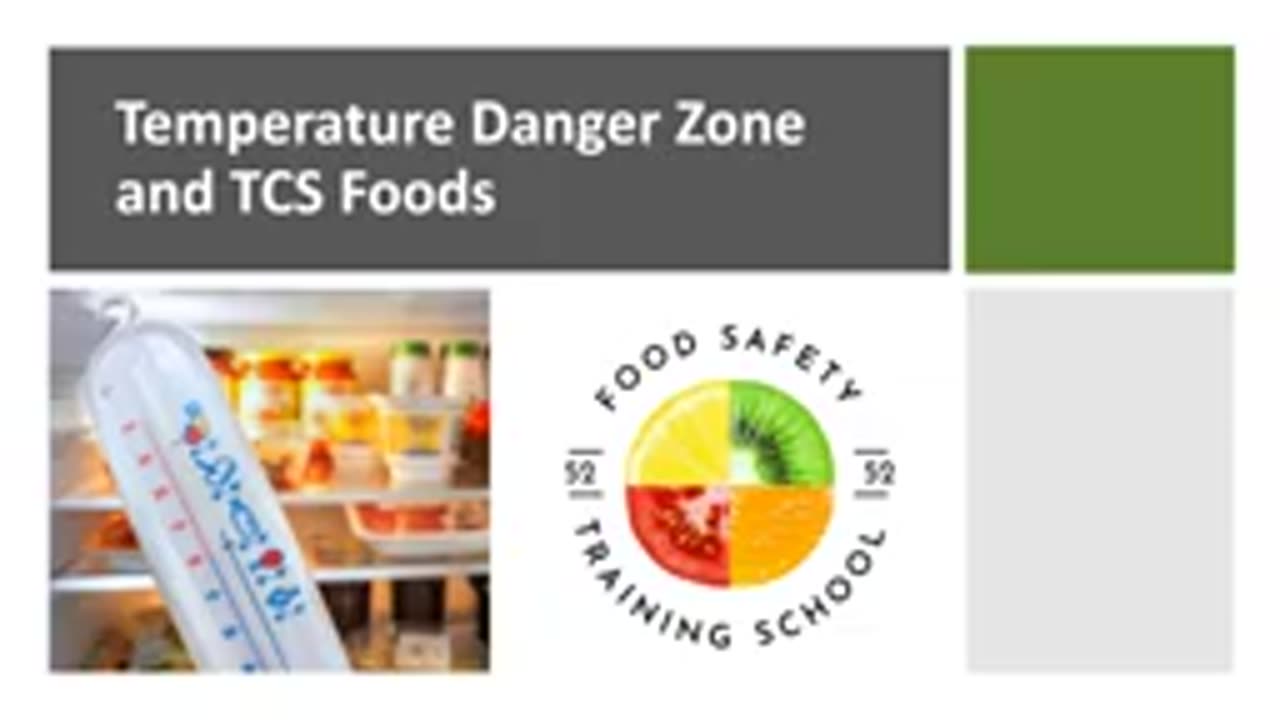Premium Only Content

Temperature Danger Zone _ TCS Foods _ Food Safety
### **Temperature Danger Zone & TCS Foods │ Food Safety**
The **Temperature Danger Zone (TDZ)** refers to the range of temperatures where bacteria can grow rapidly in food, increasing the risk of foodborne illness. Foods requiring time and temperature control for safety are known as **TCS foods**. Managing the temperature of TCS foods is essential for maintaining food safety.
---
### **What is the Temperature Danger Zone?**
- **Range:** **40°F to 140°F (4°C to 60°C)** (varies slightly by region, e.g., 41°F in some regulations).
- In this range, harmful bacteria can double in number every **20 minutes**.
- Keeping food out of this zone is critical to prevent the growth of bacteria such as *Salmonella*, *E. coli*, and *Listeria*.
---
### **What Are TCS Foods?**
**TCS (Time/Temperature Control for Safety) Foods** are foods that require specific time and temperature controls to prevent bacterial growth. These foods typically have:
- High protein content.
- Neutral to slightly acidic pH.
- High moisture content.
#### **Examples of TCS Foods**
1. **Dairy Products:**
- Milk, cheese, yogurt.
2. **Animal Proteins:**
- Poultry, meat, seafood, eggs.
3. **Cooked Grains:**
- Cooked rice, pasta, and beans.
4. **Cooked Vegetables:**
- Baked potatoes, steamed vegetables.
5. **Cut Fruits and Vegetables:**
- Sliced melons, tomatoes, leafy greens.
6. **Sprouts:**
- Alfalfa, bean sprouts.
7. **Other Foods:**
- Sauces, gravies, and tofu.
---
### **Guidelines for Managing TCS Foods**
#### **1. Keep TCS Foods Out of the Temperature Danger Zone**
- **Cold Holding:** Keep cold foods at **40°F (4°C) or below**.
- **Hot Holding:** Keep hot foods at **140°F (60°C) or above**.
- Use refrigerators, ice baths, or hot-holding equipment to maintain these temperatures.
#### **2. Time Limits**
- TCS foods can safely remain in the Temperature Danger Zone for a **maximum of 4 hours**.
- After 4 hours, food must be discarded.
#### **3. Proper Cooling**
- Cool hot foods quickly to avoid prolonged exposure to the danger zone:
- From **140°F to 70°F (60°C to 21°C)** within **2 hours**.
- From **70°F to 40°F (21°C to 4°C)** within the next **4 hours**.
- Use shallow pans, ice baths, or rapid chillers to cool foods faster.
#### **4. Proper Reheating**
- Reheat previously cooked and cooled TCS foods to **165°F (74°C)** within **2 hours** before serving.
#### **5. Thawing TCS Foods Safely**
- Thaw foods:
- In the refrigerator at **40°F (4°C)** or below.
- Under cold running water at **70°F (21°C)** or lower.
- As part of the cooking process (e.g., cooking frozen foods directly).
#### **6. Use Thermometers**
- Regularly check temperatures with calibrated food thermometers to ensure compliance.
- Measure the internal temperature of food, especially thick cuts of meat or large dishes.
---
### **Tips for Preventing Time/Temperature Abuse**
- **Plan Ahead:** Prepare foods in batches to limit the time they spend in the TDZ.
- **Monitor and Record:** Use temperature logs to track holding, cooling, and reheating processes.
- **Train Employees:** Educate food handlers on proper time and temperature control practices.
---
### **Why Managing the TDZ is Important**
- Prevents the rapid growth of bacteria that cause foodborne illnesses.
- Protects consumers and maintains food quality.
- Ensures compliance with food safety regulations.
Would you like detailed steps for cooling, reheating, or temperature monitoring protocols?
-
 1:01:17
1:01:17
The StoneZONE with Roger Stone
5 hours agoChristmas Edition: Why the Panama Canal is Part of the America First Agenda | The StoneZONE
27.8K17 -
 LIVE
LIVE
LFA TV
16 hours agoLFA TV CHRISTMAS EVE REPLAY
565 watching -
 LIVE
LIVE
tacetmort3m
23 hours ago🔴 LIVE - THE ZONE KEEPS PULLING ME BACK - STALKER 2 - PART 15
1,254 watching -
 22:45
22:45
Brewzle
13 hours agoI Went Drinking In A Real Bourbon Castle
21.9K3 -
 48:36
48:36
PMG
1 day ago $1.03 earned"Parkland Parent Speaks Out On Kamala Harris Using Victims"
15.7K3 -
 4:06
4:06
The Lou Holtz Show
11 hours agoCoach Lou Holtz’s Heartfelt Christmas Message 🎄 | Family, Faith & Notre Dame Spirit 💚 #christmas
11.8K -
![ROSEANNE BARR - Her Journey, TRUMP, and the MAGA GOLDEN AGE! [INTERVIEW]](https://1a-1791.com/video/s8/1/M/m/B/2/MmB2v.0kob.1-small-ROSEANNE-BARR-Her-Journey-T.jpg) 51:35
51:35
Dr Steve Turley
1 day ago $16.79 earnedROSEANNE BARR - Her Journey, TRUMP, and the MAGA GOLDEN AGE! [INTERVIEW]
47.4K49 -
 57:38
57:38
The Tom Renz Show
9 hours agoMerry Christmas - The Tom Renz Show Christmas
85.8K16 -
 2:59:10
2:59:10
Wendy Bell Radio
20 hours agoThe Bridge Too Far
164K300 -
 1:03:45
1:03:45
Donald Trump Jr.
1 day agoHappy Festivus: Airing Our Grievances and Stopping The Swamp w/Sean Davis | TRIGGERED Ep.201
425K545